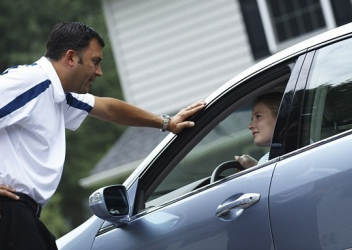Research In Action
Research In Action
Breadcrumb

One-third of autistic individuals without intellectual disability obtain a driver’s license by age 21 and two-thirds who are of legal driving age are either currently driving or planning to drive. To help establish the evidence base for future development of tailored clinical, educational, and training interventions to help these adolescents learn to drive safely, I recently published a study with colleagues from the Center for Autism Research at Children’s Hospital of Philadelphia (CHOP) and the Center for Injury Research and Prevention at CHOP to compare objective rates of crashes, traffic violations, and license suspensions for newly licensed young autistic drivers and other young drivers.
Although prior driving simulator studies suggested that young autistic drivers may be at heightened risk for motor vehicle crashes, our findings recently published in the Journal of the American Academy of Child & Adolescent Psychiatry indicate that newly licensed young autistic drivers have similar to lower per-driver rates of crash involvement than their non-autistic peers. They also have substantially lower rates of moving violations and license suspensions than other young drivers. Among those involved in a crash, autistic drivers were half as likely to crash due to speeding, but more likely to crash while making left- or U-turns and failing to yield.
We executed a unique linkage of more than 71,400 electronic health records (EHR) of children born from 1987-2000 residing in New Jersey with statewide driver licensing and crash databases to compare rates of crash involvement, traffic violations, and license suspensions among autistic and non-autistic young drivers just after licensure. We also examined the proportion of crashes attributed to specific driver actions and crash types.
Study Highlights
Rates of driving outcomes
- Over the study period, 33.5% of young autistic drivers were involved in a police-reported crash, compared with 38.1% of other young drivers.
- Young autistic drivers were 58% less likely to receive a Graduated Driver Licensing (GDL) violation, 45% less likely to be issued a moving violation, and 83% less likely to have their license suspended than other drivers.
Among drivers involved in a crash over the first 48 months of licensure, young autistic drivers were:
- Not more likely to be at fault for their crash
- 44% less likely to crash due to unsafe speed, typically a major factor in crashes involving novice young drivers
- More than three times more likely to crash while making a left-turn or U-turn
- 77% more likely to crash due to a failure to yield right of way to a vehicle or pedestrian
Our research points to the need to delve into the extent to which observed crash patterns are attributable to different driving patterns, a greater affinity to follow the rules of the road, or an active effort by families to balance independence and driving risk. Regardless, our findings suggest licensed young autistic drivers may establish driving patterns that balance independent mobility and risk—thus bringing their probability of crash involvement in line with other young drivers.
Also, by determining differences in why young autistic drivers crash as compared to others, we can establish best practices for instruction and refinement of tools and strategies to improve driving safety for novice autistic drivers. Thus far, research collectively suggests that autistic individuals may need more intensive support and tailored training to develop the range of skills needed to acquire licensure, particularly in more challenging traffic scenarios. But, once they do, they’re on their way to becoming safe independent drivers.
Clinical Guidance
In the meantime, families would benefit from guidance on how to navigate the learning-to-drive process from their healthcare providers. Providers can encourage families to:
- Seek the advice of an occupational therapist who specializes in driving or a driver rehabilitation specialist who has training in working with individuals with special needs. Visit the Association for Driver Rehabilitation Specialists website for a list of members.
- Add driving goals to their child’s individualized education plan (IEA) and follow up with school personnel. Our research has found that those with driving goals are more likely to be licensed.
- Early in adolescence, begin preparing for adulthood by identifying and promoting the acquisition of independent life skills in diverse domains, including: personal hygiene, health, food preparation, housekeeping, and transportation.
- Consider treatment for ADHD symptoms, including impulsivity and inattention, if needed.
- Provide plenty of parent-supervised driving instruction in partnership with professional driving instruction. The TeenDrivingPlan Practice Guide offers evidence-based instruction in six driving environments, at night, and in inclement weather. The online resource includes 54 short videos and accompanying instruction, as well as tips on creating the right learning environment.






